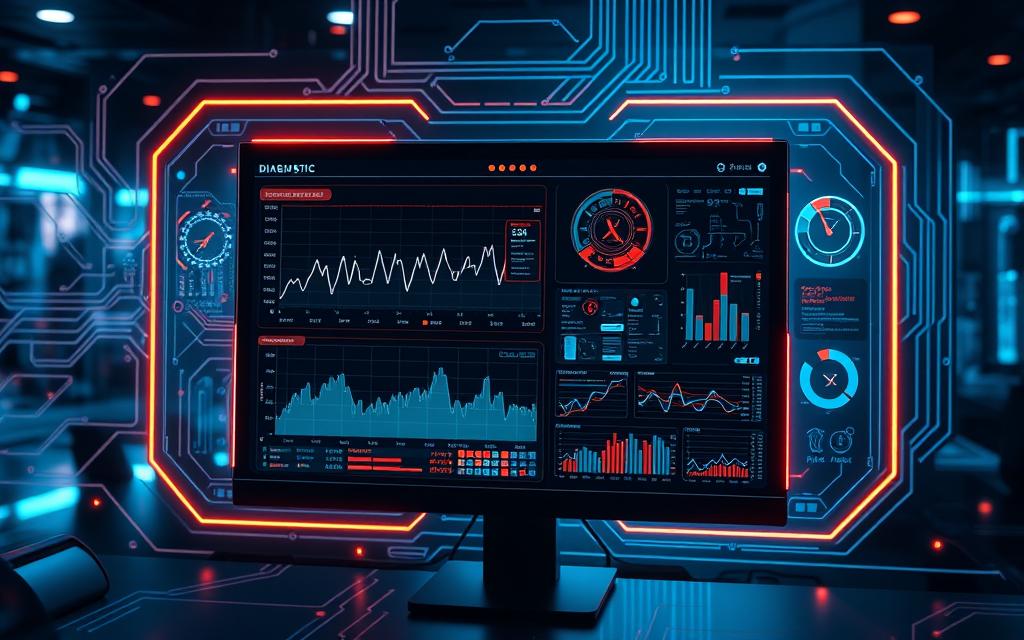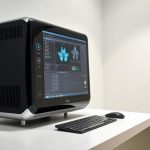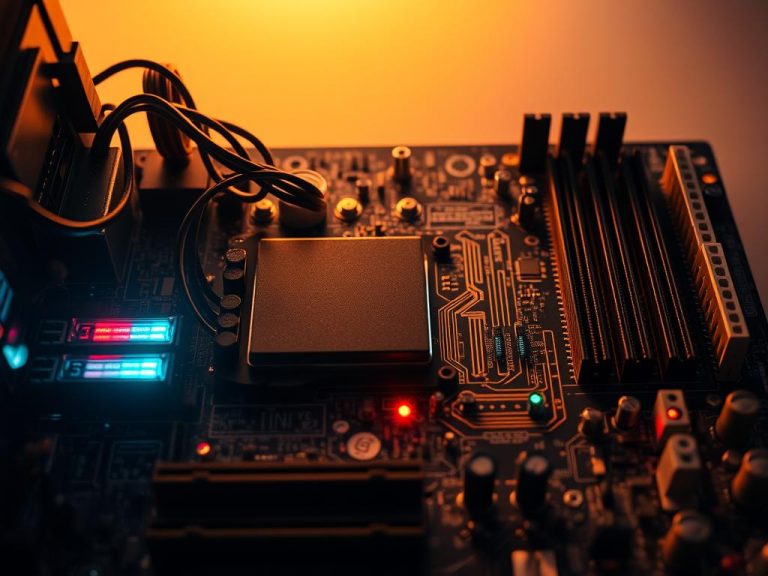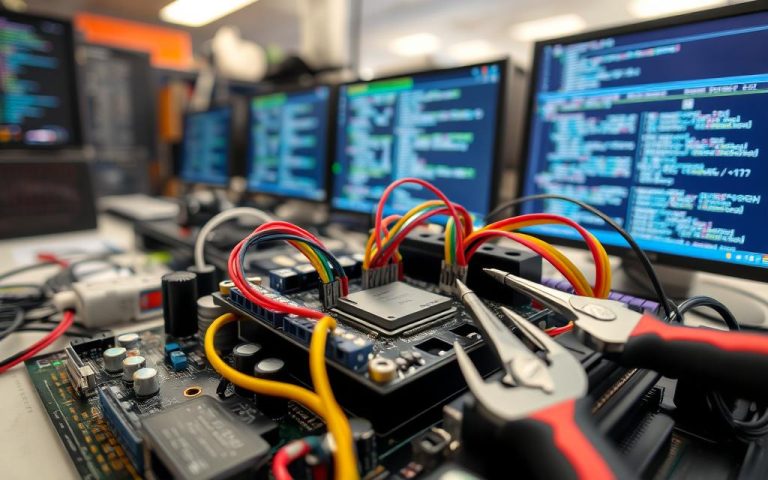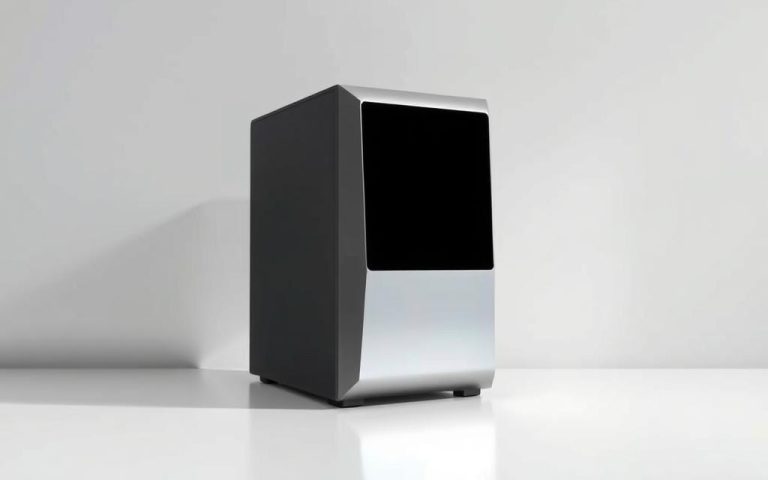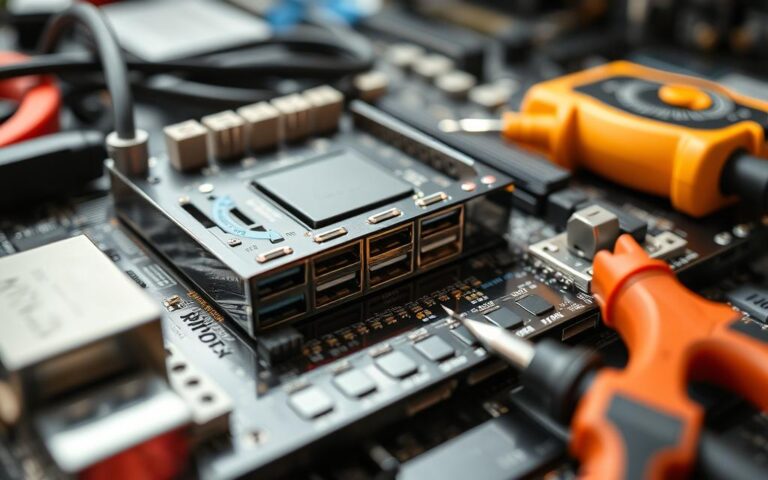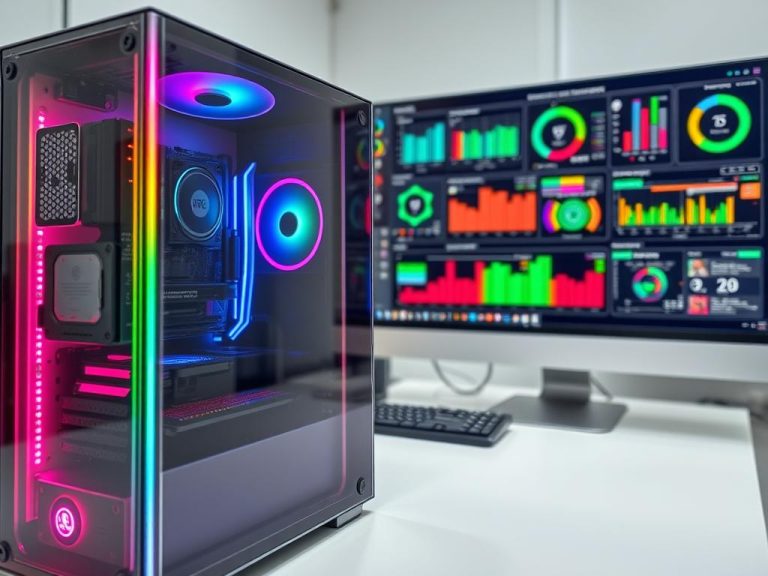What Is a Diagnostic System in a Computer? A Simple Explanation
A diagnostic system is key for keeping computers running well. It helps users find and fix problems quickly. Tools for diagnosing computers make it easier to keep them in good shape.
Every computer has a complex system that needs checking often. A diagnostic system is essential for this. It helps spot issues early, preventing big problems later.
Using diagnostic tools is a smart way to care for your computer. It helps avoid crashes and losing data.
Understanding a diagnostic system is very important. It gives users the info they need to care for their computer. Knowing how it works helps keep your computer running smoothly. In this article, we’ll explore how diagnostic systems keep computers healthy.
Understanding Computer Diagnostic Systems
Computer diagnostic systems are key for finding and fixing problems in a computer’s parts. They use diagnostic software to check the computer, find issues, and suggest fixes. Their main aim is to make sure the computer works well.
Thanks to new tech, these systems have gotten better and more precise. Computer diagnostics are now vital for keeping computers healthy, avoiding data loss, and cutting down on downtime. With diagnostic software, users can spot problems early, saving time and effort.
Diagnostic systems have hardware and software parts that work together. They let users run tests, watch system activity, and get detailed reports on the computer’s state. As tech keeps improving, diagnostic systems will likely get even better, maybe with AI and machine learning.
Definition and Basic Concepts
To really get computer diagnostic systems, you need to know the basics. This includes how hardware and software interact, setting up the system, and how to troubleshoot. Knowing these basics helps users use diagnostic software well to keep their computers running smoothly.
Key Components of Diagnostic Systems
Diagnostic systems have several parts, including:
- Hardware tools, such as circuit boards and sensors
- Software applications, including operating systems and diagnostic programs
- System configuration files and settings
These parts work together to give a full picture of the computer’s health. This lets users quickly find and fix problems.
The Core Functions of Computer Diagnostic Tools
Computer diagnostic tools are key to keeping systems running well. They help with hardware testing and fixing problems. This way, users can spot issues early and avoid bigger problems.
There are many diagnostic tools out there. Some come with the operating system, while others are third-party. Brands like Microsoft, Intel, and AMD offer tools for various tasks. These include:
- Hardware testing and troubleshooting
- System benchmarking and performance analysis
- Error detection and correction
- Driver updates and installation
These tools are vital for checking and fixing hardware. They help find problems like bad RAM or overheating CPUs. Users can also use them for regular maintenance, like cleaning disks and scanning for viruses.
In short, diagnostic tools are essential for keeping computers in top shape. They help with hardware testing and troubleshooting. This way, users can avoid crashes and data loss. With these tools, systems run smoothly and efficiently, boosting performance and productivity.
| Diagnostic Tool | Features | Compatibility |
|---|---|---|
| Microsoft Diagnostic Tool | Hardware testing, troubleshooting, system benchmarking | Windows 10, Windows 11 |
| Intel Diagnostic Tool | Hardware testing, system analysis, driver updates | Windows 10, Windows 11, Linux |
| AMD Diagnostic Tool | Hardware testing, system benchmarking, overclocking | Windows 10, Windows 11, Linux |
What Is a Diagnostic System in Computer Hardware Testing
A diagnostic system is key in checking computer hardware. It helps find and fix problems with a computer’s parts. It does this by testing memory, CPU, and storage devices.
Testing and keeping hardware in check is important. It stops systems from failing and keeps them running well. A diagnostic system finds issues early, so they can be fixed quickly.
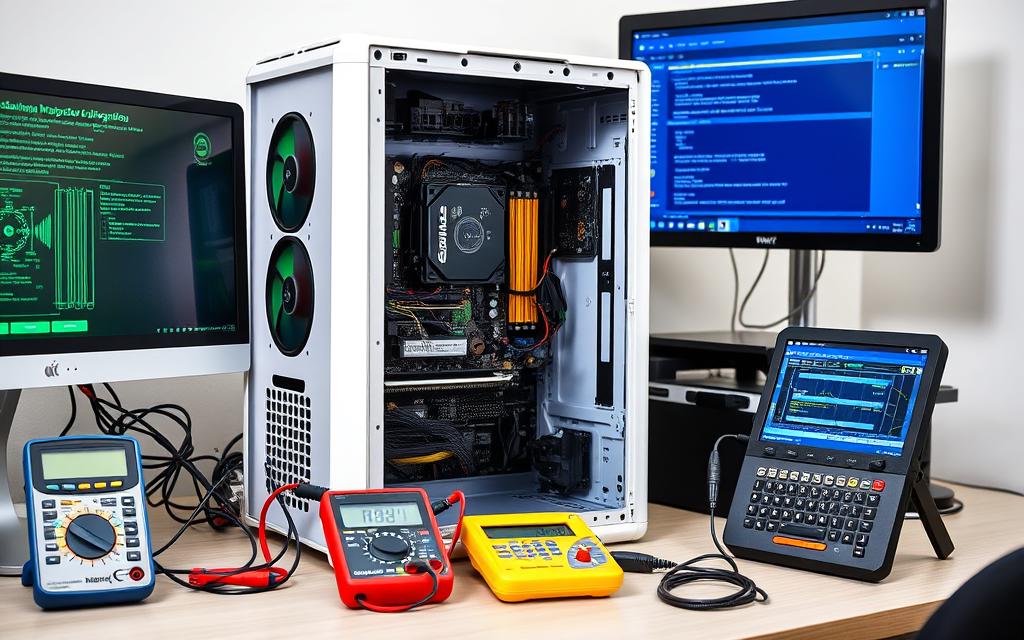
Memory Testing Capabilities
Memory testing is a big part of a diagnostic system. It checks RAM and other memory parts for problems. It looks for memory leaks and corruption that slow down systems.
CPU Diagnostics
CPU diagnostics test the computer’s brain, the CPU. It checks if the CPU is working right. It looks at speed, temperature, and other things that affect how well the system works.
Storage Device Analysis
Storage device analysis tests hard drives and solid-state drives. It makes sure they work well. It checks for disk errors and corruption that slow down systems.
Using a diagnostic system keeps computers running smoothly. It stops small problems from becoming big ones. It’s great for fixing issues because it finds the main problem and shows how to fix it.
Software-Based Diagnostic Solutions
Computer diagnostic tools and software are key in fixing computer problems. They help identify and solve issues with computer systems. These tools can be divided into operating system diagnostics, third-party tools, and cloud-based services.
A diagnostic program checks if software, hardware, or a system is working right. It gives advice on any problems found. Using these tools keeps your system running well.
Operating System Diagnostics
Operating system diagnostics are built into the OS to find and fix problems. They can do deeper checks and have changed over time. Now, they use different methods and architectures.
Third-Party Diagnostic Tools
Third-party tools offer many features, like memory testing and CPU diagnostics. They help find and fix issues that OS diagnostics might miss.
Cloud-Based Diagnostic Services
Cloud-based services are easy and affordable for diagnosing computer problems. They can be accessed from anywhere, making it simpler to get help.
Using computer diagnostic tools and software has many benefits:
- It makes your system run better.
- It boosts security.
- It makes things more efficient.
With these diagnostic solutions, you can keep your computer running smoothly. Any problems will be found and fixed quickly.
| Diagnostic Solution | Features | Benefits |
|---|---|---|
| Operating System Diagnostics | Integrated into the operating system | Convenient and easy to use |
| Third-Party Diagnostic Tools | Range of features and functionalities | Can identify and resolve issues not detected by operating system diagnostics |
| Cloud-Based Diagnostic Services | Remote access and cost-effective | Convenient and easy to use |
The Role of BIOS in System Diagnostics
The Basic Input/Output System (BIOS) is key in diagnostic software and hardware testing. It checks and fixes problems with computer parts. This makes sure systems work well and fast.
BIOS does many important things in system checks. These include:
- Hardware component detection
- Configuration and setup of hardware devices
- Diagnostic testing of hardware components
It’s vital to keep BIOS up to date. This ensures systems can find and fix problems quickly. It also makes systems work better and faster.
Using diagnostic software and hardware testing tools helps make computers better. BIOS is a big part of keeping systems running well. It helps with fixing common problems and regular upkeep.
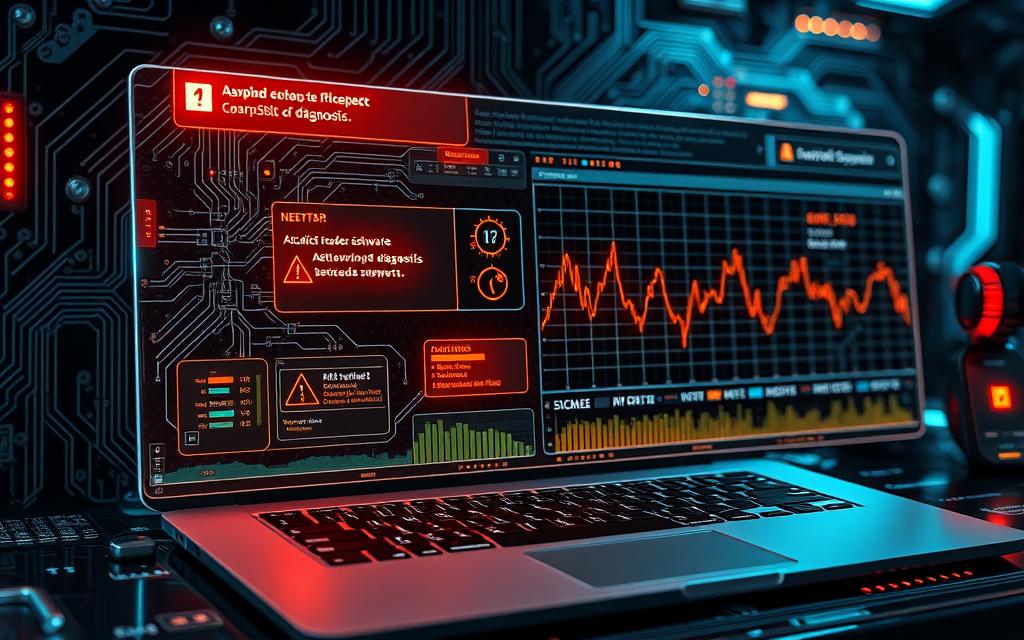
Knowing how BIOS helps with system checks lets users keep their computers in top shape. This way, they can avoid hardware failures and keep systems running smoothly.
| BIOS Version | Diagnostic Features |
|---|---|
| Legacy BIOS | Basic hardware detection and configuration |
| UEFI BIOS | Advanced hardware detection, configuration, and diagnostic testing |
Common Computer Issues Detected by Diagnostic Systems
Diagnostic systems are key in spotting and fixing common computer problems. They help users find and fix issues quickly. This keeps systems running smoothly. Regular checks with a diagnostic system can stop problems before they start.
Hardware Malfunctions
Problems like bad RAM or a failing hard drive can be found by a diagnostic system. These issues can slow down or even crash your system. A diagnostic system finds the problem, helping users fix it and avoid more damage.
Software Conflicts
Software issues, like bad drivers or malware, can also be found. These can make your system slow or crash. A diagnostic system helps find and fix these problems, keeping your system running well.
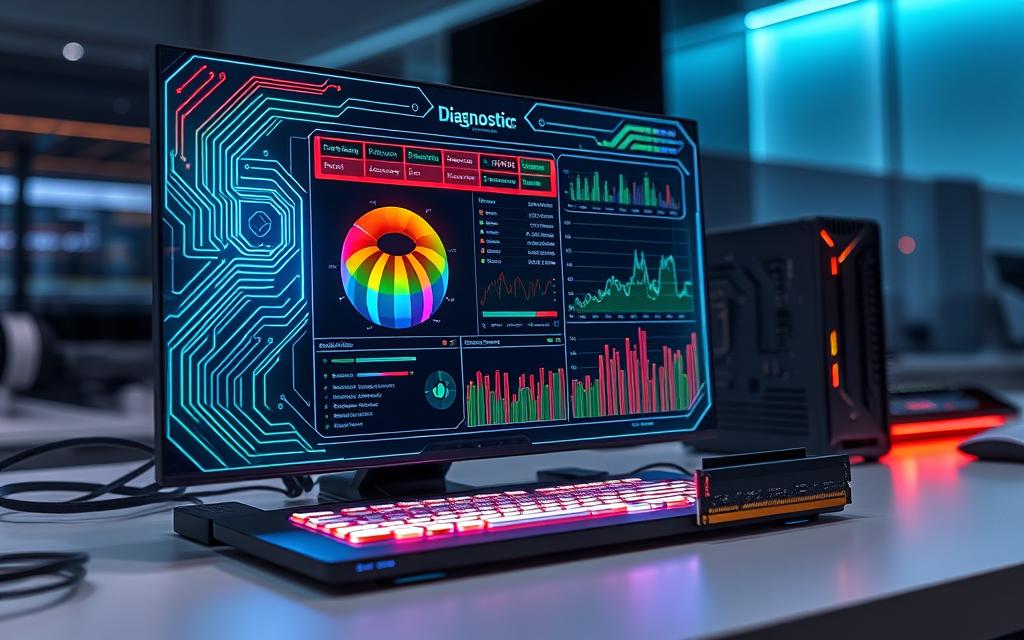
Diagnostic systems also find performance bottlenecks. They help users see where their system can improve. Regular checks help keep your system running at its best.
Benefits of Regular Diagnostic Testing
Regular diagnostic testing is key to keeping computer systems running smoothly. It helps spot problems early, so you can fix them before they get worse. Computer diagnostic tools and diagnostic software are great for finding issues like hardware problems and software bugs.
Regular checks offer many advantages. Here are a few:
- Improved system performance
- Increased reliability
- Reduced downtime
- Early detection of problems
- Proactive steps to avoid system failures
By doing regular tests, you keep your system in top shape. Use computer diagnostic tools and diagnostic software to watch how your system is doing. This is a vital part of keeping your computer running well.
Advanced Diagnostic Features in Modern Computers
Modern computers now have advanced diagnostic features. These changes have changed how we find and fix problems. They use new technologies like artificial intelligence and predictive analysis.
These tools are getting smarter, thanks to hardware testing. They can spot tiny issues. Computers can even predict problems before they happen. This means we can fix things before they cause trouble.
- They find problems more accurately
- They fix things faster
- Systems work better overall
- They can predict and prevent problems
As technology keeps getting better, we’ll see even more cool uses of hardware testing and diagnostic tools. These changes could really change how we work and do things. They’re an exciting part of the future of computers.
| Diagnostic Feature | Description |
|---|---|
| Artificial Intelligence | Enables predictive analysis and automated issue detection |
| Predictive Analysis | Allows for proactive maintenance and minimises downtime |
| Remote Diagnostic Capabilities | Enables remote access for technicians to diagnose and resolve issues |
Conclusion: Embracing Diagnostic Tools for Better Computer Health
Diagnostic software and tools are key to keeping our computers running smoothly. They help us spot hardware problems and tweak system settings. This lets us fix issues before they cause trouble and get the most out of our devices.
By making these tools a part of our routine, we protect our investments. Our computers stay reliable and perform well. This is thanks to embracing diagnostic tools in our maintenance routine.
The future of diagnostic tools looks bright. They will use artificial intelligence and predictive analytics to get even better. Soon, they will offer instant insights and solutions to problems before they start.
This means our computers will work more efficiently and last longer. We’ll be more productive and enjoy a better digital experience. Advanced diagnostic tools are set to take our computers to new levels.
FAQ
What is the purpose of a diagnostic system in a computer?
A diagnostic system in a computer is key for finding and fixing hardware and software problems. It makes sure the computer runs smoothly by spotting and solving issues early on.
What are the key components of a diagnostic system?
A diagnostic system includes tools for testing hardware, software solutions, and BIOS diagnostics. Together, they give a full check of the computer’s performance and find any problems.
How do diagnostic systems help with computer hardware testing?
Diagnostic systems are vital for testing computer hardware. They check memory, CPU, and storage devices thoroughly. This helps find and fix any hardware issues that could slow down the computer.
What are the benefits of regular diagnostic testing?
Regular testing boosts system performance and reliability. It also cuts down on downtime. By spotting issues early, users can prevent major problems and keep their computers running well.
How have diagnostic systems evolved over time?
Diagnostic systems have changed a lot, using new tech and methods. They now include AI and remote testing. These updates help find and fix problems more easily, keeping computers running smoothly.
What is the role of BIOS in system diagnostics?
The BIOS is essential for system diagnostics. It has built-in tools for checking hardware. These tools help find and fix hardware problems before the operating system starts.
What are the common computer issues that diagnostic systems can detect?
Diagnostic systems can spot many computer problems. These include hardware failures, software conflicts, and performance issues. They help users fix these problems and keep their computers running well.
How do advanced diagnostic features, such as artificial intelligence and predictive analysis, enhance the capabilities of modern computers?
Modern computers benefit from advanced diagnostic features like AI and predictive analysis. These features make testing more accurate and efficient. They help find problems before they happen, preventing system failures.

